View in other NatureServe Network Field Guides
NatureServe
Montana
Utah
Wyoming
Idaho
Wisconsin
British Columbia
South Carolina
Yukon
California
New York
White-footed Deermouse - Peromyscus leucopus
Native Species
Global Rank:
G5
State Rank:
S4
(see State Rank Reason below)
Agency Status
USFWS:
USFS:
BLM:
External Links
State Rank Reason (see State Rank above)
Species is restricted to riparian forests and shrublands along rivers and streams in eastern Montana. It has likely declined with the reduction of these habitats as the forests were cleared for agriculture and ongoing lack of recruitment of cottonwood trees due to the altered hydrology within some of these systems. It faces threats from additional habitat loss from these issues.
General Description
Adults are reddish brown (juveniles gray), with a white belly, white feet, membranous ears, and bicolored tail (usually not sharply bicolored); adult total length 145 to 205 mm, tail 62 to 97 mm (usually shorter than head and body), hind foot 18 to 24 mm, ear 13 to 19 mm; 16 to 29 g in the northeastern U.S.; 3 pairs of mammae (Paradiso 1960, Godin 1977, Hall 1981).
Diagnostic Characteristics
Often difficult to distinguish from P. maniculatus. In New England, differs from P. maniculatus by having coarser and redder pelage, a more well-defined mid-dorsal stripe, a tail that is less distinctly white on the ventral surface and that seldom is as long as the head and body, and a broader rostrum (Godin 1977). See Hoffmeister (1986) for differences from Peromyscus species in the southwestern U.S.
Species Range
Montana Range
Range Descriptions
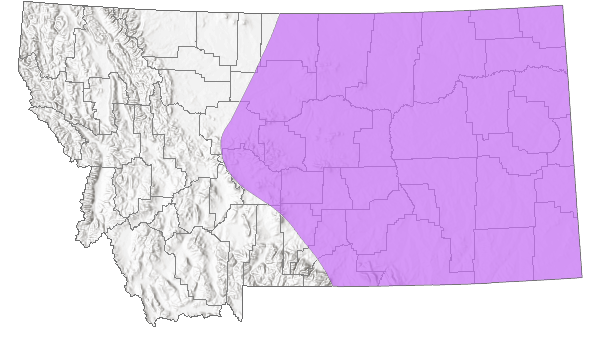
 Native
Native
Western Hemisphere Range

Observations in Montana Natural Heritage Program Database
Number of Observations: 136
(Click on the following maps and charts to see full sized version)
Map Help and Descriptions
Relative Density
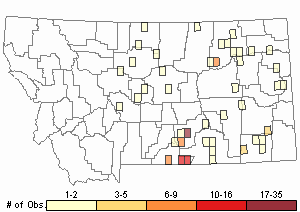
Recency
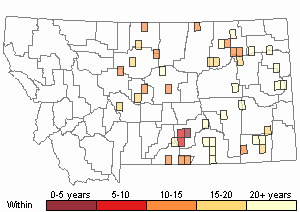
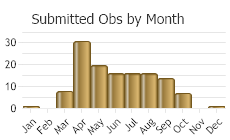
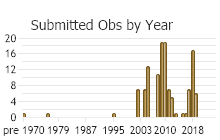
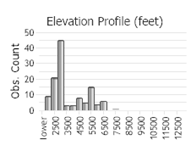 (Observations spanning multiple months or years are excluded from time charts)
(Observations spanning multiple months or years are excluded from time charts)
Migration
Non-migratory.
Habitat
Riparian woodland, dendritic distribution, uses thickets, shrubs. Nest 7 inches in diameter of plant materials.
Ecological Systems Associated with this Species
- Details on Creation and Suggested Uses and Limitations
How Associations Were Made
We associated the use and habitat quality (common or occasional) of each of the 82 ecological systems mapped in Montana for
vertebrate animal species that regularly breed, overwinter, or migrate through the state by:
- Using personal observations and reviewing literature that summarize the breeding, overwintering, or migratory habitat requirements of each species (Dobkin 1992, Hart et al. 1998, Hutto and Young 1999, Maxell 2000, Foresman 2012, Adams 2003, and Werner et al. 2004);
- Evaluating structural characteristics and distribution of each ecological system relative to the species' range and habitat requirements;
- Examining the observation records for each species in the state-wide point observation database associated with each ecological system;
- Calculating the percentage of observations associated with each ecological system relative to the percent of Montana covered by each ecological system to get a measure of "observations versus availability of habitat".
Species that breed in Montana were only evaluated for breeding habitat use, species that only overwinter in Montana were only evaluated for overwintering habitat use, and species that only migrate through Montana were only evaluated for migratory habitat use.
In general, species were listed as associated with an ecological system if structural characteristics of used habitat documented in the literature were present in the ecological system or large numbers of point observations were associated with the ecological system.
However, species were not listed as associated with an ecological system if there was no support in the literature for use of structural characteristics in an ecological system,
even if point observations were associated with that system.
Common versus occasional association with an ecological system was assigned based on the degree to which the structural characteristics of an ecological system matched the preferred structural habitat characteristics for each species as represented in scientific literature.
The percentage of observations associated with each ecological system relative to the percent of Montana covered by each ecological system was also used to guide assignment of common versus occasional association.
If you have any questions or comments on species associations with ecological systems, please contact the Montana Natural Heritage Program's Senior Zoologist.
Suggested Uses and Limitations
Species associations with ecological systems should be used to generate potential lists of species that may occupy broader landscapes for the purposes of landscape-level planning.
These potential lists of species should not be used in place of documented occurrences of species (this information can be requested at:
mtnhp.mt.gov/requests) or systematic surveys for species and evaluations of habitat at a local site level by trained biologists.
Users of this information should be aware that the land cover data used to generate species associations is based on imagery from the late 1990s and early 2000s and was only intended to be used at broader landscape scales.
Land cover mapping accuracy is particularly problematic when the systems occur as small patches or where the land cover types have been altered over the past decade.
Thus, particular caution should be used when using the associations in assessments of smaller areas (e.g., evaluations of public land survey sections).
Finally, although a species may be associated with a particular ecological system within its known geographic range, portions of that ecological system may occur outside of the species' known geographic range.
Literature Cited
- Adams, R.A. 2003. Bats of the Rocky Mountain West; natural history, ecology, and conservation. Boulder, CO: University Press of Colorado. 289 p.
- Dobkin, D. S. 1992. Neotropical migrant land birds in the Northern Rockies and Great Plains. USDA Forest Service, Northern Region. Publication No. R1-93-34. Missoula, MT.
- Foresman, K.R. 2012. Mammals of Montana. Second edition. Mountain Press Publishing, Missoula, Montana. 429 pp.
- Hart, M.M., W.A. Williams, P.C. Thornton, K.P. McLaughlin, C.M. Tobalske, B.A. Maxell, D.P. Hendricks, C.R. Peterson, and R.L. Redmond. 1998. Montana atlas of terrestrial vertebrates. Montana Cooperative Wildlife Research Unit, University of Montana, Missoula, MT. 1302 p.
- Hutto, R.L. and J.S. Young. 1999. Habitat relationships of landbirds in the Northern Region, USDA Forest Service, Rocky Mountain Research Station RMRS-GTR-32. 72 p.
- Maxell, B.A. 2000. Management of Montana's amphibians: a review of factors that may present a risk to population viability and accounts on the identification, distribution, taxonomy, habitat use, natural history, and the status and conservation of individual species. Report to U.S. Forest Service Region 1. Missoula, MT: Wildlife Biology Program, University of Montana. 161 p.
- Werner, J.K., B.A. Maxell, P. Hendricks, and D. Flath. 2004. Amphibians and reptiles of Montana. Missoula, MT: Mountain Press Publishing Company. 262 p.
- Commonly Associated with these Ecological Systems
Forest and Woodland Systems
Grassland Systems
Human Land Use
Recently Disturbed or Modified
Shrubland, Steppe and Savanna Systems
Wetland and Riparian Systems
- Occasionally Associated with these Ecological Systems
Shrubland, Steppe and Savanna Systems
Food Habits
Somewhat omnivorous. Seeds, fruits and insects are dominant items, with order of importance varying between season and ranges.
Ecology
Semi-arboreal.
Reproductive Characteristics
Probably restricted to warmer months with peaks in March to April and September to October, in midsummer heat reporduction may slow down.
Stewardship Responsibility
References
- Literature Cited AboveLegend:
 View Online Publication
View Online Publication Hall, E.R. 1981. The mammals of North America, volumes I and II. John Wiley & Sons, New York, NY. 1181 pp.
Hall, E.R. 1981. The mammals of North America, volumes I and II. John Wiley & Sons, New York, NY. 1181 pp. Hoffmeister, D.F. 1986. Mammals of Arizona. Univ. Arizona Press and Arizona Game and Fish Dept. 602 pp.
Hoffmeister, D.F. 1986. Mammals of Arizona. Univ. Arizona Press and Arizona Game and Fish Dept. 602 pp. Paradiso, J.L. 1960. A new white-footed mouse (Peromyscus leucopus) from southeastern Virginia. Proceedings of the Biological Society of Washington 73:21-23.
Paradiso, J.L. 1960. A new white-footed mouse (Peromyscus leucopus) from southeastern Virginia. Proceedings of the Biological Society of Washington 73:21-23.
- Additional ReferencesLegend:
 View Online Publication
View Online Publication
Do you know of a citation we're missing? Bendell, J.F. 1961. Some factors affecting the habitat selection of the white-footed mouse. Can. Field-Nat. 75(4):244-255.
Bendell, J.F. 1961. Some factors affecting the habitat selection of the white-footed mouse. Can. Field-Nat. 75(4):244-255. Blem, L.B., and C.R. Blem. 1975. The effect of flooding onlength of residency in the white-footed mouse, Peromyscus leucopus. Am. Midl. Nat. 94(1):232-236.
Blem, L.B., and C.R. Blem. 1975. The effect of flooding onlength of residency in the white-footed mouse, Peromyscus leucopus. Am. Midl. Nat. 94(1):232-236. Bramblett, R.G., and A.V. Zale. 2002. Montana Prairie Riparian Native Species Report. Montana Cooperative Fishery Research Unit, Montana State University - Bozeman.
Bramblett, R.G., and A.V. Zale. 2002. Montana Prairie Riparian Native Species Report. Montana Cooperative Fishery Research Unit, Montana State University - Bozeman. Cummings, J.R. and S.H. Vessey. 1994. Agricultural influences on movements of white-footed mice (Peromyscus leucopus). American Midland Naturalist 132:209-218.
Cummings, J.R. and S.H. Vessey. 1994. Agricultural influences on movements of white-footed mice (Peromyscus leucopus). American Midland Naturalist 132:209-218. Foresman, K.R. 2001. The wild mammals of Montana. American Society of Mammalogists, Special Publication Number 12. Lawrence, KS. 278 pp.
Foresman, K.R. 2001. The wild mammals of Montana. American Society of Mammalogists, Special Publication Number 12. Lawrence, KS. 278 pp. Foresman, K.R. 2012. Mammals of Montana. Second edition. Mountain Press Publishing, Missoula, Montana. 429 pp.
Foresman, K.R. 2012. Mammals of Montana. Second edition. Mountain Press Publishing, Missoula, Montana. 429 pp. Hanauska-Brown, L., B.A. Maxell, A. Petersen, and S. Story. 2014. Diversity Monitoring in Montana 2008-2010 Final Report. Montana Fish, Wildlife & Parks. Helena, MT. 78 pp.
Hanauska-Brown, L., B.A. Maxell, A. Petersen, and S. Story. 2014. Diversity Monitoring in Montana 2008-2010 Final Report. Montana Fish, Wildlife & Parks. Helena, MT. 78 pp. Hendricks, P., S. Lenard, D.M. Stagliano, and B.A. Maxell. 2013. Baseline nongame wildlife surveys on the Fort Peck Indian Reservation. Report to the Assiniboine and Sioux Tribes of the Fort Peck Indian Reservation. Montana Natural Heritage Program, Helena, MT. 83 p.
Hendricks, P., S. Lenard, D.M. Stagliano, and B.A. Maxell. 2013. Baseline nongame wildlife surveys on the Fort Peck Indian Reservation. Report to the Assiniboine and Sioux Tribes of the Fort Peck Indian Reservation. Montana Natural Heritage Program, Helena, MT. 83 p. Hoffmann, R.S. and D.L. Pattie. 1968. A guide to Montana mammals: identification, habitat, distribution, and abundance. Missoula, MT: University of Montana. 133 p.
Hoffmann, R.S. and D.L. Pattie. 1968. A guide to Montana mammals: identification, habitat, distribution, and abundance. Missoula, MT: University of Montana. 133 p. Joslin, Gayle, and Heidi B. Youmans. 1999. Effects of recreation on Rocky Mountain wildlife: a review for Montana. [Montana]: Montana Chapter of the Wildlife Society.
Joslin, Gayle, and Heidi B. Youmans. 1999. Effects of recreation on Rocky Mountain wildlife: a review for Montana. [Montana]: Montana Chapter of the Wildlife Society. Kaufman, D.W., M.E. Peak, G.A. Kaufman. 1985. Peromyscus leucopus in riparian woodlands: use of trees and shrubs. J. Mammal. 66(1)139-143.
Kaufman, D.W., M.E. Peak, G.A. Kaufman. 1985. Peromyscus leucopus in riparian woodlands: use of trees and shrubs. J. Mammal. 66(1)139-143. Kaufman, D.W., S.K. Peterson, R. Fristik and G.A. Kaufman. 1983. Effect of microhabitat features on habitat use by Peromyscus leucopus. Amer. Midl. Nat. 110(1): 177-185.
Kaufman, D.W., S.K. Peterson, R. Fristik and G.A. Kaufman. 1983. Effect of microhabitat features on habitat use by Peromyscus leucopus. Amer. Midl. Nat. 110(1): 177-185. Kaufman, G.A., D.W. Kaufman and E.J. Finck. 1988. Influence of fire and topography on habitat selection by Peromyscus maniculatus and Reithrodontomys megalotis in ungrazed tallgrass prairie. Journal of Mammalogy 69:342-352.
Kaufman, G.A., D.W. Kaufman and E.J. Finck. 1988. Influence of fire and topography on habitat selection by Peromyscus maniculatus and Reithrodontomys megalotis in ungrazed tallgrass prairie. Journal of Mammalogy 69:342-352. Krohne, D.T. and R. Baccus. 1985. Genetic and ecological structure of a population of Peromyscus leucopus. Journal of Mammalogy. 66:529-537.
Krohne, D.T. and R. Baccus. 1985. Genetic and ecological structure of a population of Peromyscus leucopus. Journal of Mammalogy. 66:529-537. Lackey, J.A., D.G. Huckaby, and B.G. Ormiston. 1985. Peromyscus leucopus. Mammalian Species 247:1-10.
Lackey, J.A., D.G. Huckaby, and B.G. Ormiston. 1985. Peromyscus leucopus. Mammalian Species 247:1-10. Matthews, W.L. 1981. Broadus-Pumpkin Creek baseline inventory - wildlife. Bureau of Land Management, Miles City, MT. 83 p.
Matthews, W.L. 1981. Broadus-Pumpkin Creek baseline inventory - wildlife. Bureau of Land Management, Miles City, MT. 83 p. Montana Dept. of State Lands. U.S. Office of Surface Mining., 1985, Draft Environmental Impact Statement. Consolidation Coal Company. CX Ranch Mine, Big Horn County, Montana.
Montana Dept. of State Lands. U.S. Office of Surface Mining., 1985, Draft Environmental Impact Statement. Consolidation Coal Company. CX Ranch Mine, Big Horn County, Montana. Reichel, J.D. 1986. Habitat use by alpine mammals in the Pacific Northwest. Arctic and Alpine Research. 18(1): 111-119.
Reichel, J.D. 1986. Habitat use by alpine mammals in the Pacific Northwest. Arctic and Alpine Research. 18(1): 111-119. Reid, F. 2006. Peterson Field Guide to Mammals of North America, 4th Edition. Houghton Mifflin Company: Boston and New York, 608 pp.
Reid, F. 2006. Peterson Field Guide to Mammals of North America, 4th Edition. Houghton Mifflin Company: Boston and New York, 608 pp. Scow, K.L. 1981. Ecological distribution of small mammals at Sarpy Creek, Montana, with special consideration of the Deer Mouse, Peromyscus maniculatus. M.Sc. Thesis. Bozeman, Montana: Montana State University. 73 p.
Scow, K.L. 1981. Ecological distribution of small mammals at Sarpy Creek, Montana, with special consideration of the Deer Mouse, Peromyscus maniculatus. M.Sc. Thesis. Bozeman, Montana: Montana State University. 73 p. Sullivan, Daniel, 1982, Bait stations as a means of rodenticide presentation to control Columbian ground squirrrels. Technical Rep. 82-3. Sept. 1982.
Sullivan, Daniel, 1982, Bait stations as a means of rodenticide presentation to control Columbian ground squirrrels. Technical Rep. 82-3. Sept. 1982. Williams, O. 1955. Distribution of mice and shrews in a Colorado montane forest. J. Mammal. 36(2): 221-231.
Williams, O. 1955. Distribution of mice and shrews in a Colorado montane forest. J. Mammal. 36(2): 221-231.
- Web Search Engines for Articles on "White-footed Deermouse"
- Additional Sources of Information Related to "Mammals"





